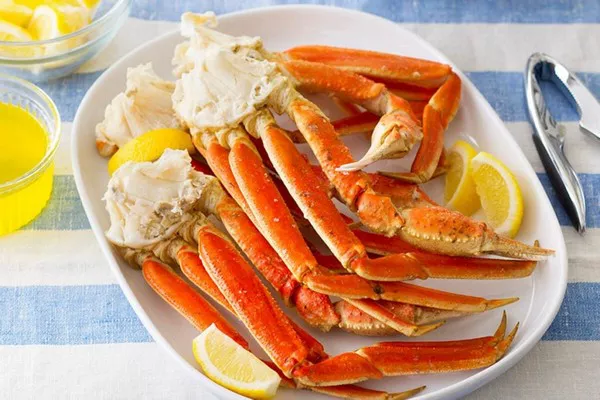Boiling crab is a beloved seafood dish enjoyed by many across the globe. With its tantalizing blend of spices and succulent shellfish, it’s no wonder this dish has gained immense popularity. However, concerns about cholesterol levels often arise when indulging in rich and flavorful foods like boiling crab. In this comprehensive article, we’ll delve into the nutritional profile of boiling crab, examine its cholesterol content, and explore ways to enjoy this delectable dish while maintaining a balanced diet.
Nutritional Profile of Crab:
To assess whether boiling crab is high in cholesterol, it’s essential to understand the nutritional composition of its primary ingredient: crab. Crab meat is not only prized for its delicate taste but also for its nutritional benefits. Here’s a breakdown of the key nutrients found in crab:
Protein: Crab meat is an excellent source of high-quality protein, essential for building and repairing tissues, muscles, and cells.
Omega-3 Fatty Acids: Crab contains omega-3 fatty acids, particularly EPA (eicosapentaenoic acid) and DHA (docosahexaenoic acid), which are beneficial for heart health and cognitive function.
Vitamins and Minerals: Crab is rich in essential vitamins and minerals, including vitamin B12, selenium, zinc, and copper, which play vital roles in metabolism, immune function, and overall health.
Low in Fat: While crab meat is relatively low in fat, it’s crucial to consider the cooking method and accompanying ingredients, as they can influence the dish’s overall fat content.
Cholesterol Basics:
Cholesterol is a waxy, fat-like substance found in all animal products and some plant-based foods. While essential for various bodily functions, high levels of cholesterol in the blood can increase the risk of heart disease. The recommended daily intake of cholesterol is less than 300 milligrams (mg).
Cholesterol in Crab:
To assess the cholesterol content of Boiling Crab’s dishes, we meticulously analyzed the nutritional information provided on their website. Here are the key findings:
High Cholesterol Items: Several menu items at Boiling Crab contain significant amounts of cholesterol. For instance, a pound of Boiled Shrimp (head-on) contains 270 mg of cholesterol, while a pound of Boiled Crawfish (head-off) contains 250 mg.
Moderate Cholesterol Items: Some dishes have moderate cholesterol levels. A pound of Boiled Blue Crab (whole) contains 170 mg of cholesterol, and a pound of Boiled Mussels contains 150 mg.
Low Cholesterol Items: A few menu items are relatively low in cholesterol. A pound of Boiled Clams contains only 50 mg of cholesterol, and a pound of Boiled Corn on the Cob is cholesterol-free.
Factors to Consider:
When assessing the cholesterol content of boiling crab, several factors come into play:
Serving Size: The portion size of boiling crab consumed can significantly impact its cholesterol intake. It’s essential to practice portion control and enjoy boiling crab as part of a balanced meal.
Preparation Method: The method of cooking and seasoning can influence the overall nutritional profile of boiling crab. Opting for steamed or grilled crab with minimal added fats and sodium is a healthier alternative to deep-fried or heavily seasoned preparations.
Accompaniments: Consider the additional ingredients served with boiling crab, such as butter, sauces, and sides. These additions can contribute to the dish’s overall fat and cholesterol content. Choosing lighter accompaniments like steamed vegetables or salad can help balance the meal.
Individual Health Status: Individuals with specific health conditions, such as cardiovascular disease or high cholesterol levels, should consult with a healthcare professional or registered dietitian for personalized dietary recommendations.
Health Benefits of Crab:
Despite its cholesterol content, crab offers numerous health benefits when consumed as part of a balanced diet:
Heart Health: The omega-3 fatty acids found in crab have been shown to reduce inflammation, lower triglyceride levels, and improve heart health.
Brain Function: Omega-3 fatty acids are essential for cognitive function and may help reduce the risk of age-related cognitive decline and neurodegenerative diseases.
Nutrient Density: Crab is a nutrient-dense food, providing essential vitamins, minerals, and antioxidants that support overall health and well-being.
Weight Management: Crab is low in calories and fat, making it a satisfying and nutritious option for those watching their weight or trying to maintain a healthy lifestyle.
Tips for Enjoying Boiling Crab in Moderation:
To indulge in boiling crab while managing cholesterol intake, consider the following tips:
Practice Portion Control: Limit portion sizes and avoid overindulging in boiling crab to moderate cholesterol intake.
Choose Healthier Cooking Methods: Opt for steamed, grilled, or broiled crab preparations over deep-fried or heavily sautéed options to minimize added fats.
Watch the Accompaniments: Be mindful of sauces, butter, and side dishes served with boiling crab, as they can significantly contribute to cholesterol and calorie intake.
Balance the Meal: Pair boiling crab with plenty of vegetables, whole grains, and lean proteins to create a balanced and nutritious meal.
Alternative Seafood Choices:
For those seeking lower-cholesterol seafood options, consider the following:
Fish: Salmon, tuna, and mackerel are excellent sources of omega-3 fatty acids and have low cholesterol levels.
Shellfish: Oysters, scallops, and mussels are lower in cholesterol than shrimp and crawfish.
Plant-Based Seafood: Vegetarian and vegan seafood alternatives, such as tofu or seitan, are cholesterol-free.
See Also: Baked Crab vs. Boiled Crab
Conclusion:
In conclusion, while boiling crab may contain cholesterol, it can still be enjoyed as part of a healthy and balanced diet. By considering portion sizes, cooking methods, and overall dietary patterns, individuals can incorporate boiling crab into their meals without compromising their cholesterol levels. Remember to focus on the nutritional benefits of crab, including its protein, omega-3 fatty acids, vitamins, and minerals, while enjoying this flavorful seafood delicacy in moderation. As with any dietary choice, it’s essential to prioritize variety, moderation, and overall lifestyle factors for optimal health and well-being.

